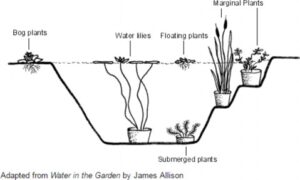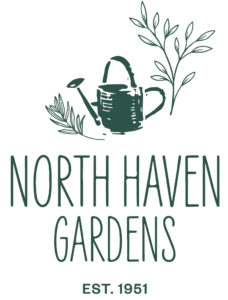Whether you are planning to install plants at the edge of a naturally occurring body of water or in a newly created artificial pond, proper plant selection and care are the keys to success. After installing the hardscape of your pond, it is time to establish the softscape (plant materials). The softscape creates a pleasant appearance, but also helps create a balanced ecosystem to keep the pond healthy as well as beautiful.
Site Considerations: Most water plants do well in direct sunlight. Consider also the exposure to winter wind and the depth of ice that accumulates over winter. When selecting plants, keep in mind the hardiness zone factor. Ponds have varying water movement, from no moving water to swift moving water. Plants need to be chosen that will thrive in the existing water conditions.

Plant Selection Process: There are five categories of water plants that can be included in a pond to achieve perfect balance. Water lilies and lily‐like aquatics, marginal plants, bog or moisture-loving plants, submerged or oxygenating plants and floating plants (see reverse).
Planting: The best time to move most water plants is during their growing season, from late spring until the end of summer. Containerized plants can be moved while dormant and placed in the pond. The best time to move submerged plants is spring or fall. Do not purchase the plants until you are ready to plant because you do not want them to dry out.
Water Lilies: The hardy lilies grow from rhizomes. They are best grown in soil-filled containers set in the pond. Lilies can be introduced to the pond from spring to early fall.
Care After Planting: Your pond may look bare at first, but after a couple of months the plants will mature and flourish. If your pond water becomes murky and fills with algae, do not change the water. Give the pond time to reach its balance. Fertilize with pond tabs pressed into the soil near the roots and groom as needed.
Water Plant Categories
Water Lilies and Lily-like Aquatics: These grow on the base of the pond and send up leaves and blooms to the surface. Depending on the variety, they may grow a couple of inches to a few feet below the surface of the water. They provide valuable leaf cover to help shade the water, which reduces algae growth. Fish love to hide under the leaves too. Lilies do not do well with strong water movement or splashing water. Most species need full sun 10 hours a day for best blooms. NHG carries both tropical and hardy water lilies (Nymphaea) as well as a few kinds of tropical Lotus (Nelumbo).
Marginal Plants: These grow in the shallow margins around the edge of the pond. It is helpful if a shelf is incorporated in the pond design to support them. Marginal plants can be decorative, provide shelter from the wind, and offer a bit of shade. These plants do best in still to slow moving water. Try Thalia, Pickerel Weed, Rushes, and others for marginal plantings.
Bog or Moisture-loving Plants: These grow in damp soil at the edge of ponds and prefer to have only the tips of their roots submerged. They also do best in still to slow moving water. Start with a mixture of marginal plants and bog plants inhabiting about 1/3 of the circumference of the pond. Try Cannas, Bog Irises, Bog Lobelia, and others for these plantings.
Submerged or Oxygenating Plants: The roots of these plants are anchored in soil, but the leaves stay underwater. Their foliage is usually fern‐like, lacy, or hairy. They play a vital role in maintaining the pond’s natural balance. These plants use waste nutrients and help purify the water. This, in turn, creates an environment that is unsuitable for algal growth. They also provide cover for microscopic forms of life. It is best to include one bunch (these plants are sold by the ‘bunch’ or handful) for every two square feet of pond surface. Fewer bunches may be adequate once the natural balance is obtained. Grow a variety of species since each species grows at a different time of year and has different water depth requirements.
Floating Plants: These plants do not need soil or a base of any kind. As the name implies, they are simply suspended in the water. They provide decoration and shade and help reduce algal growth. One bunch is sufficient for every 10-15 square feet. These plants are vigorous growers and will need to be thinned periodically. Try Mosaic Plant, Azolla and Floating Clover (Marsilea).

